Introduction
- It is essential to study the milestones of child development, as a set of signals and strategies, to maintain the growth and development of a child. It is a valuable resource for parents and child care providers to a better comprehension of this issue.
- By providing the illustrations, this project aims at visually demonstrating the difference between sensory development and perception abilities of infants and toddlers.
- Observing children is considered the best way to “asses and document developmental milestones”, as they are subjected to new skills they try to master (Petty 3).
- The evidence presented are based on the multiple studies and researches in Milestones Of Child Development (2008).
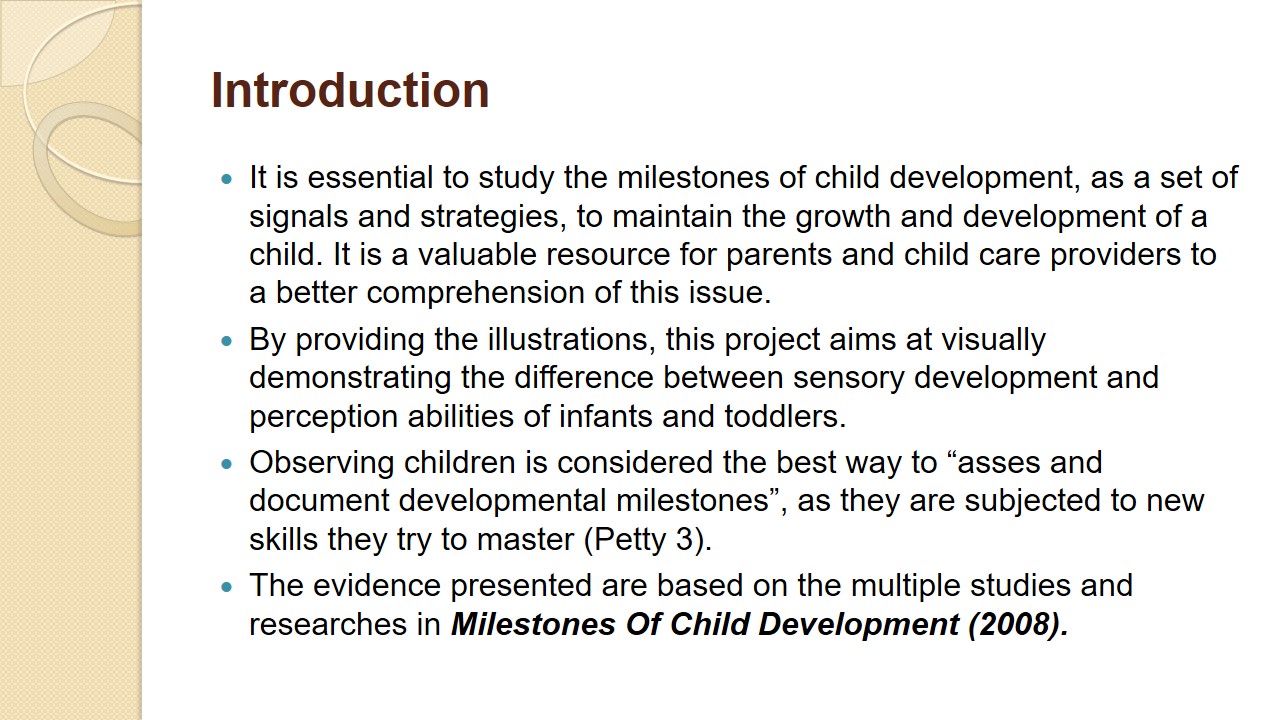
Small unbreakable mirror
An infant might use this to interact with self in the mirror as if it were another person.
This correlates to the social/emotional domain in Milestones of Child Development, Strand 2: Learning about Self (Self-concept): B2. Gain an emerging sense of self as separate from but also connected to others.
A toddler may recognize this item that belongs to oneself by saying, “mine”.
This correlates to the social/emotional domain in Milestones of Child Development, Strand 2: Learning about Self (Self-concept): B9. Show increasing ability to distinguish between self and others.
A mirror might also be a good motivation for a toddler to start crawling and moving in front of it, and perform almost any other imaginative movement in response to self reflection in it.
This correlates to the Fine Arts domain in Milestones of Child Development, Strand 1: Dance Arts: A9. Show creativity using their bodies.
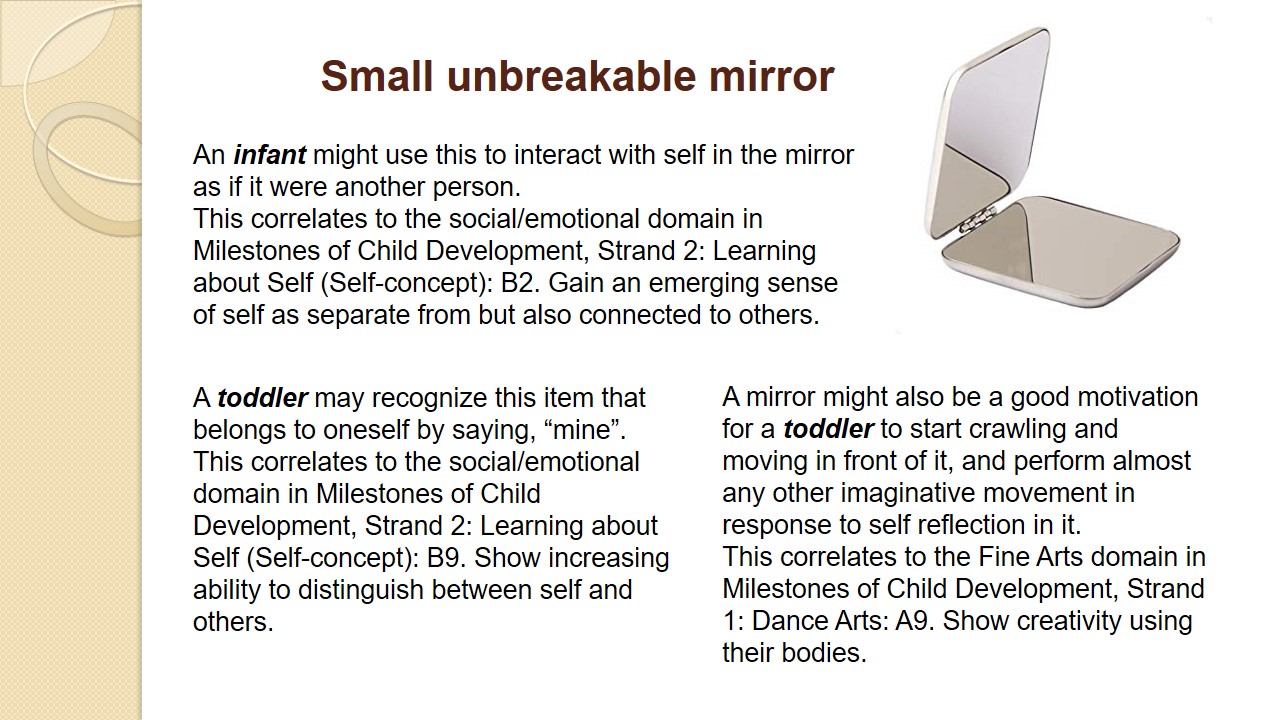
Soft bristle toothbrush and soft bristle hairbrush
An infant may explore these items as new toys to see what happens when it is pushed, pulled, punched, dropped, rolled, shaken, or covered with towel.
This correlates to the approaches to learning domain in Milestones of Child Development, Strand 3: Creativity and Inventiveness: C2. Approach and explore new experiences in familiar settings.
A toddler might use these items to participate in getting ready for bed and sleeping routines, specifically through fun activities.
This correlates to the physical development and health domain in Milestones of Child Development, Strand 3: Health and Well-Being: C3. Participate in basic health and safety routines.
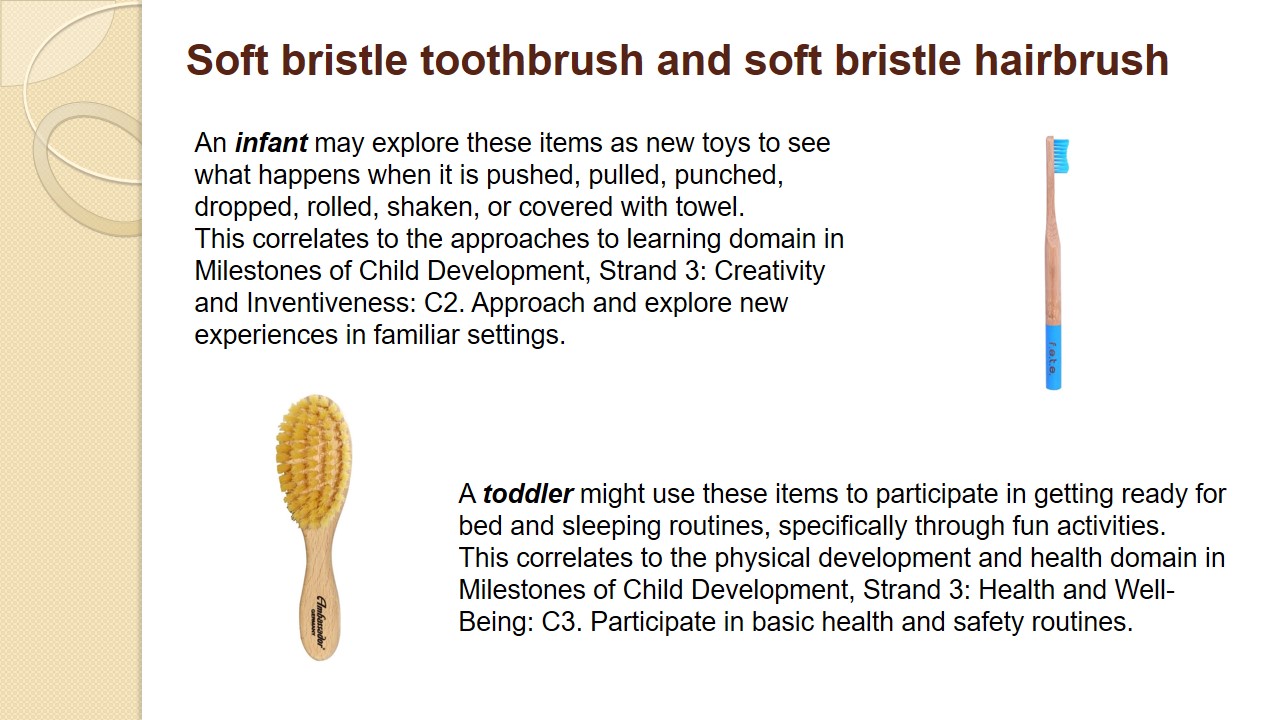
Small colored balls
An infant might reach and grab the small colored balls.
This correlates to the cognition and general knowledge domain in Milestones of Child Development, Strand 1: Sub-Strand B. Measurement: B1. Explore objects in their environment.
Together with a container, such as a the muffin tin or even egg carton, they might be a great way for infant’s exploration and motivation, and to infant motor development.
This correlates to the physical development and health domain in Milestones of Child Development, Strand 1: Gross Motor Development: A2. Demonstrate proficiency in rolling over, sitting, crawling.
A toddler might drop small colored balls into the container while standing over it, or throw them into it. This which facilitates science skills, hand-eye coordination and fine and large motor skills.
This correlates to the cognition and general knowledge domain in Milestones of Child Development, Strand 2 Sub-Strand A. Scientific Knowledge: A4. Build beginning understanding of basic science concepts (e.g., force and motion, gravity, sound, light) through exploration.
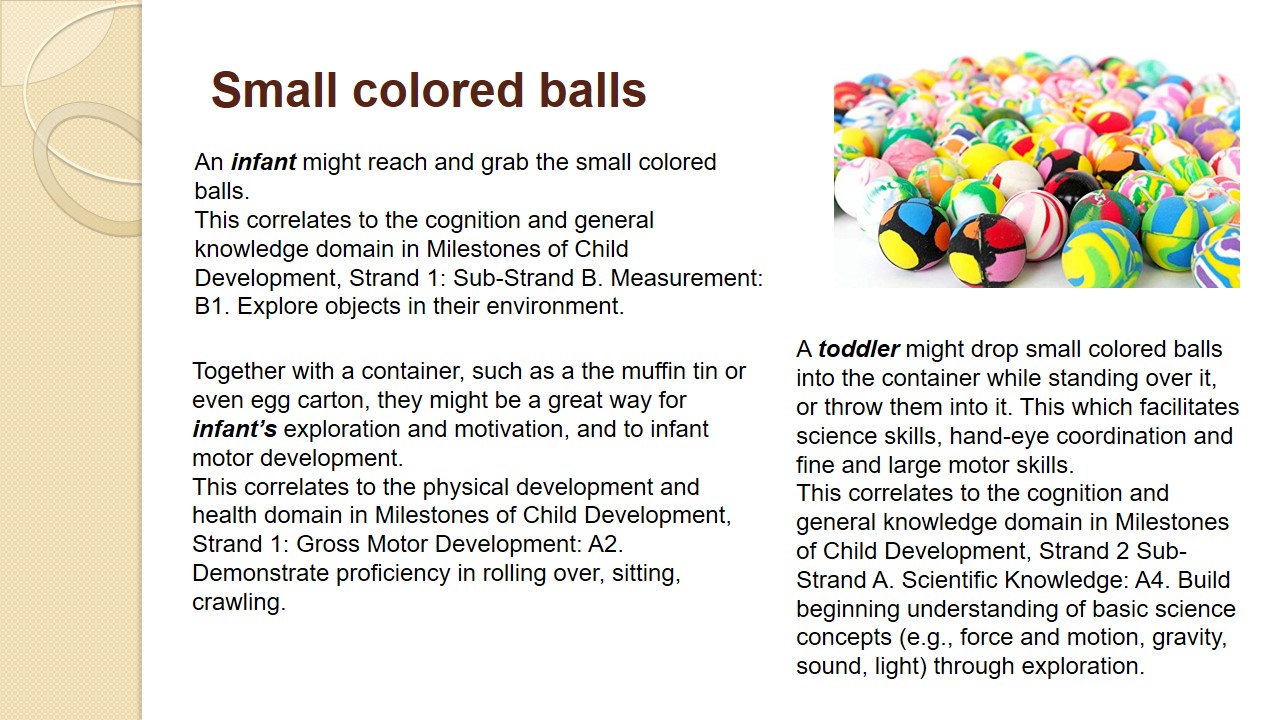
A medium size ball
An infant might push a ball to watch it roll or even try to roll over it as on a therapy ball for babies.
This correlates to the approaches to learning domain in Milestones of Child Development, Strand 4: Reasoning and Problem-Solving: D1. Explore object characteristics in many different ways.
A toddler may move it into position to catch a ball, and then throw the ball in the right direction.
This correlates to the physical development and health domain in Milestones of Child Development, Strand 1: Gross Motor Development: A7. Coordinate movements in more complex gross motor tasks, such as throwing, catching, kicking, bouncing balls, and using the slide and swing.
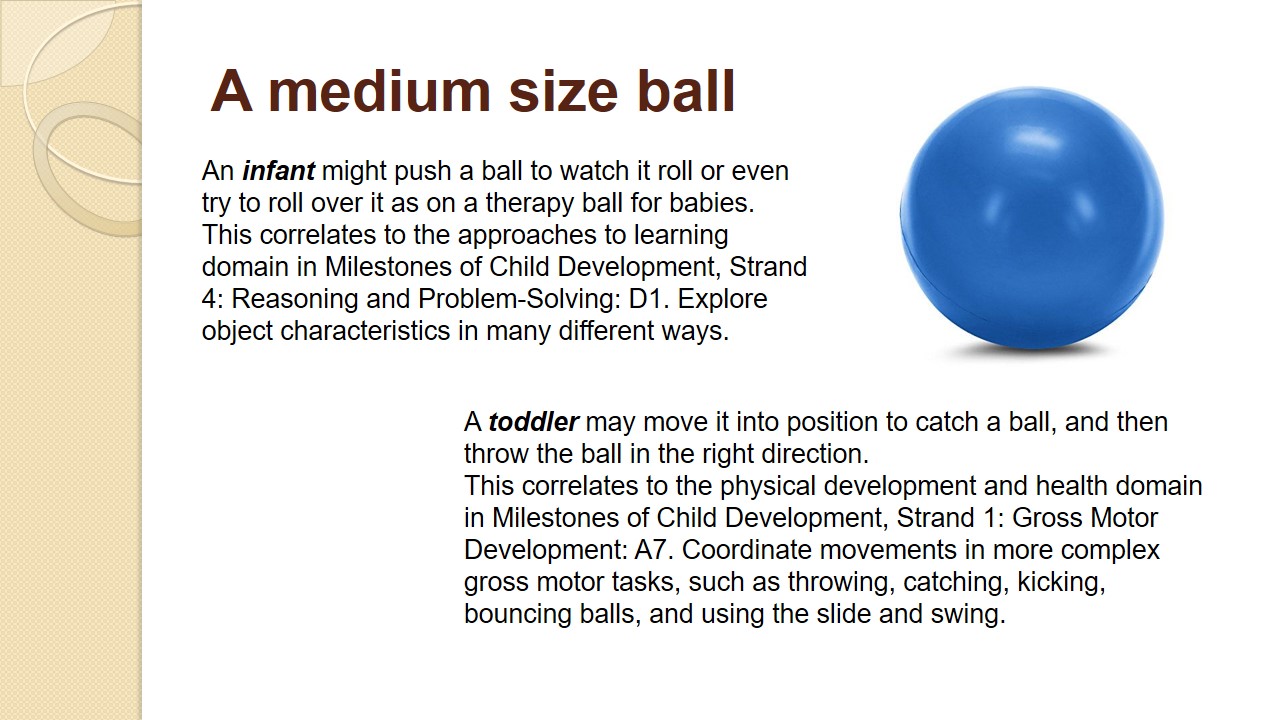
Hand puppet
An infant might explore objects placed in hands.
This correlates to the approaches to learning domain in Milestones of Child Development, Strand 4: Reasoning and Problem-Solving: D1. Explore object characteristics in many different ways.
An infant might explore objects placed in hands.
This correlates to the approaches to learning domain in Milestones of Child Development, Strand 4: Reasoning and Problem-Solving: D1. Explore object characteristics in many different ways.
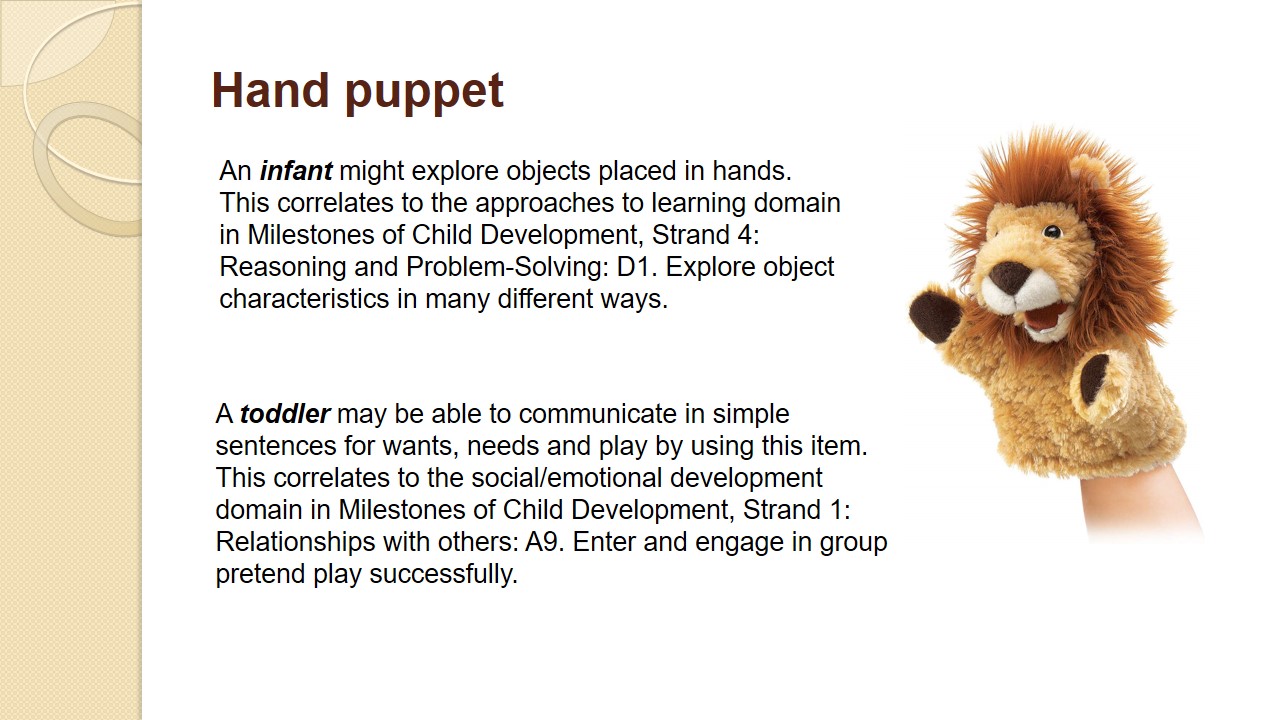
Colored straws
An infant might mouth, shake, bang, drop, or throw shape the straws.
This correlates to the cognition and general knowledge domain in Milestones of Child Development, Strand 1: Sub-Strand D. Shapes: D1. Explore geometric shapes in the environment.
A toddler might use this item as a help in drinking water or juice.
This correlates to the cognition and general knowledge domain in Milestones of Child Development, Strand 2: Sub-Strand B. Scientific inquiry and exploration: B11. Begin to use simple tools and equipment for investigation.
A toddler might also use the straws for the art session by dipping them in the paint and turn it into the stamp to create art with.
This correlates to the fine arts domain in Milestones of Child Development, Strand 4: Visual Arts: D4. Experiment with a variety of art materials.
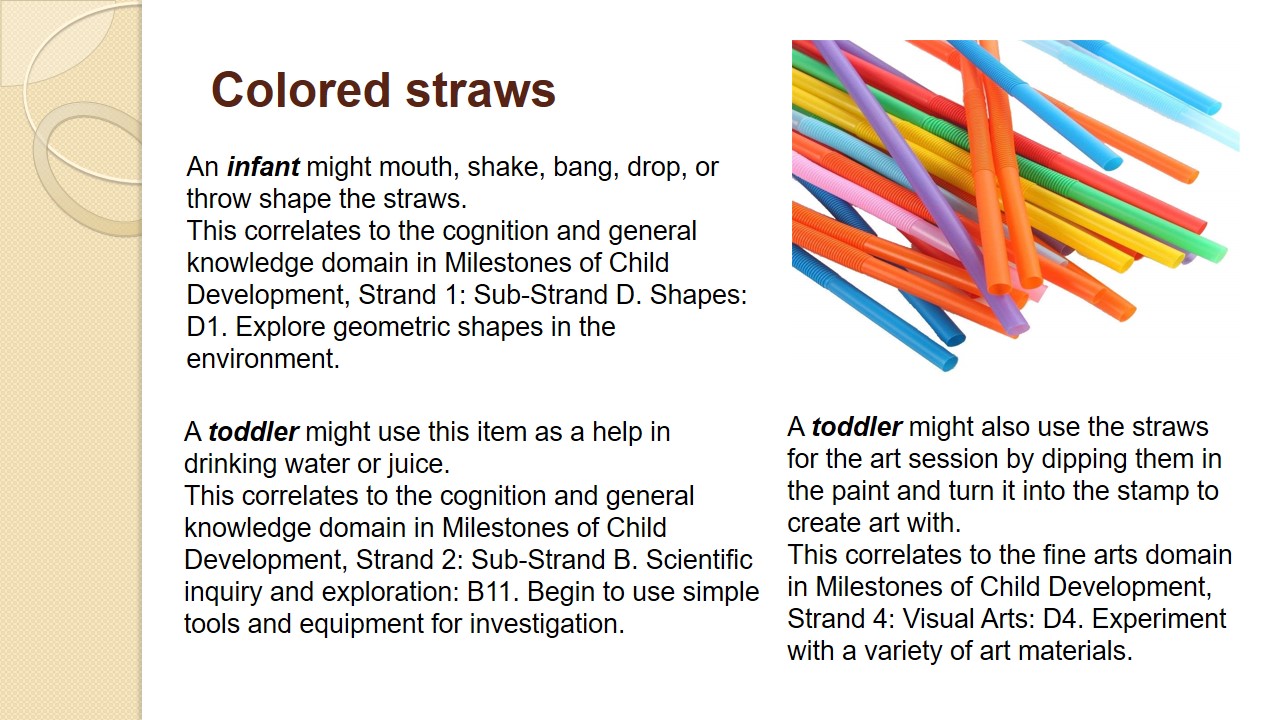
Long colored scarf
An infant might use a scarf to develop the sense of touch.
This correlates to the fine arts domain in Milestones of Child Development, Strand 4: Visual Arts: D2. Explore the texture of different mediums (e.g., fabrics of different textures).
A toddler may put a scarf on oneself when feeling cold.
This correlates to the physical development and health domain in Milestones of Child Development, Strand 3: Health and Well-Being: C12. Perform self-care tasks independently.
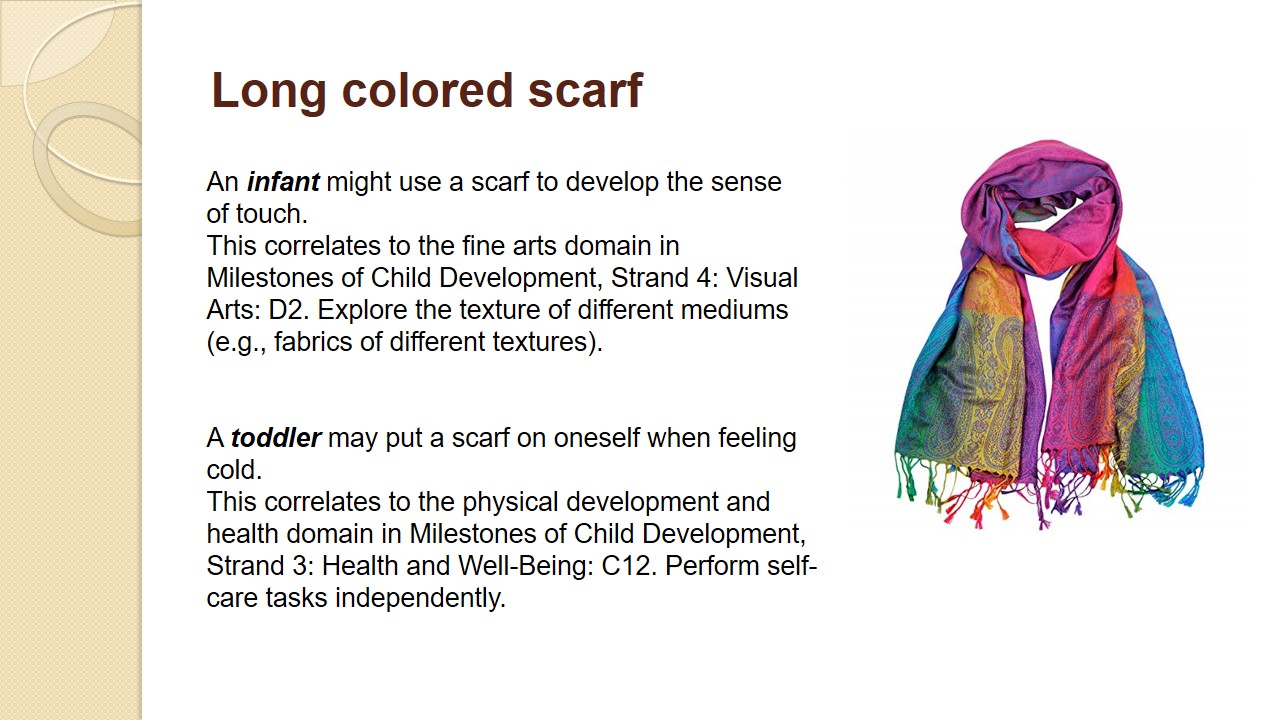
Unbreakable magnifying glass
An infant might explore an object using all senses.
This correlates to the approaches to learning domain in Milestones of Child Development, Strand 2: Curiosity and Initiative: B2. Engage in and actively explore self, objects, and surroundings.
A toddler might use this item to examine natural materials.
This correlates to the cognition and general knowledge domain in Milestones of Child Development, Strand 2: Sub-Strand B. Scientific Inquiry and Exploration: B14. Begin to collect, describe, and record information.
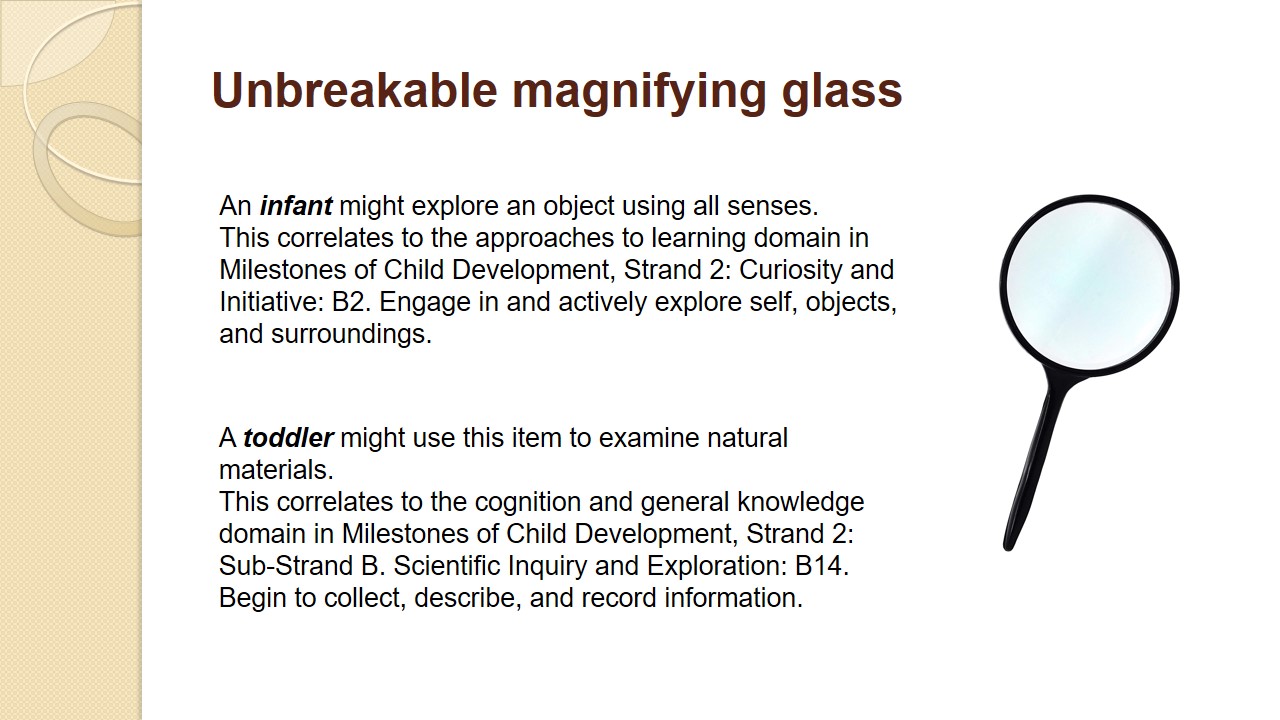
Baby blanket
An infant might use this item as a comfort object to reduce arousal or distress when feeling stressed or upset.
This correlates to the social/emotional development domain in Milestones of Child Development, Strand 3: Emotion Regulation and Self-Regulation: C1. Develop increasing emotion regulation.
A toddler might use this item to engage in pretend play to extend a favorite story or field trip experience.
This correlates to the fine arts domain in Milestones of Child Development, Strand 3: Theater Arts: C8. Participate with others in dramatic play, negotiating roles and setting up events.
Baby blanket might be also used by a toddler to build an indoor fort or tent; or as a parachute to toss around different sized balls or soft objects. This facilitates toddler’s imagination and gross motor skills.
This correlates to the approaches to learning domain in Milestones of Child Development, Strand 3: Creativity & Inventiveness: C8. Approach tasks and activities with increased flexibility, imagination, and inventiveness.
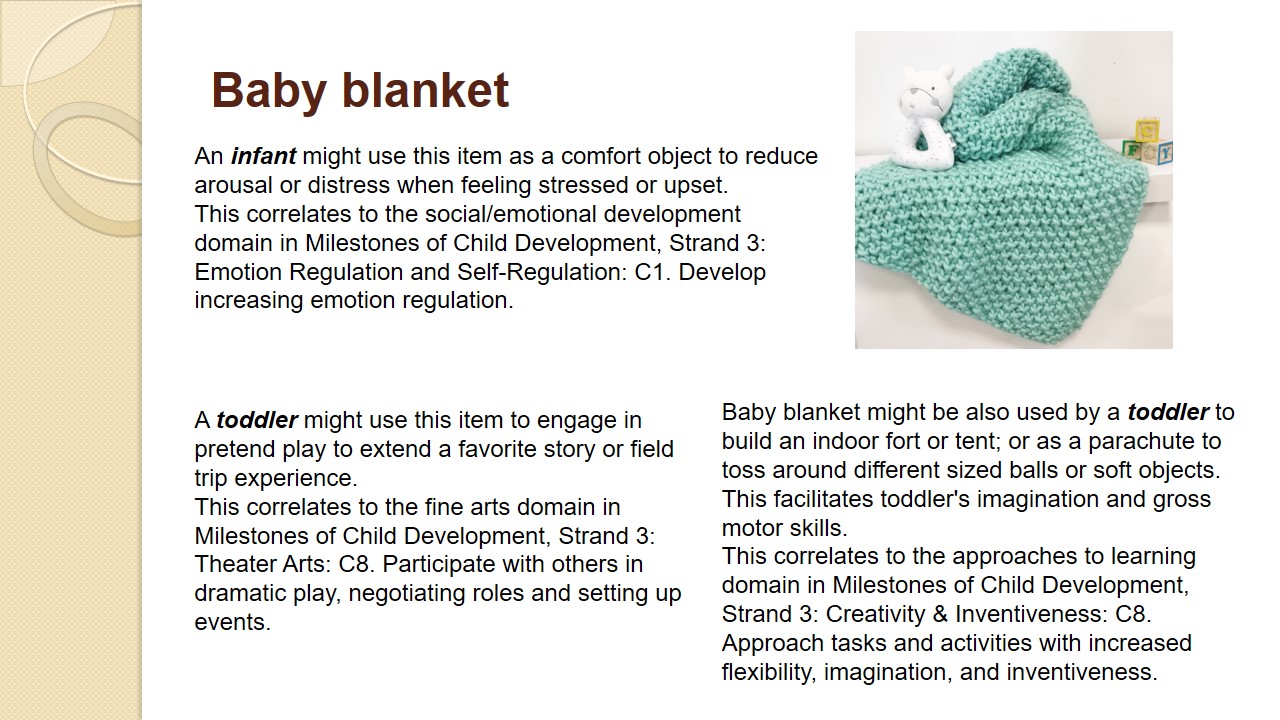
Rattle
An infant may shake the rattle.
This correlates to the fine arts domain in Milestones of Child Development, Strand 2: Music: B3. Experiment with a variety of sound sources (e.g., rattles, bells).
A toddler might shake this item to create a sound to dance, march, hop, jump, sway, clap, snap, stamp, twist, turn during movement activities.
This correlates to the fine arts domain in Milestones of Child Development, Strand 1: Dance Arts: A9. Show creativity using their bodies.
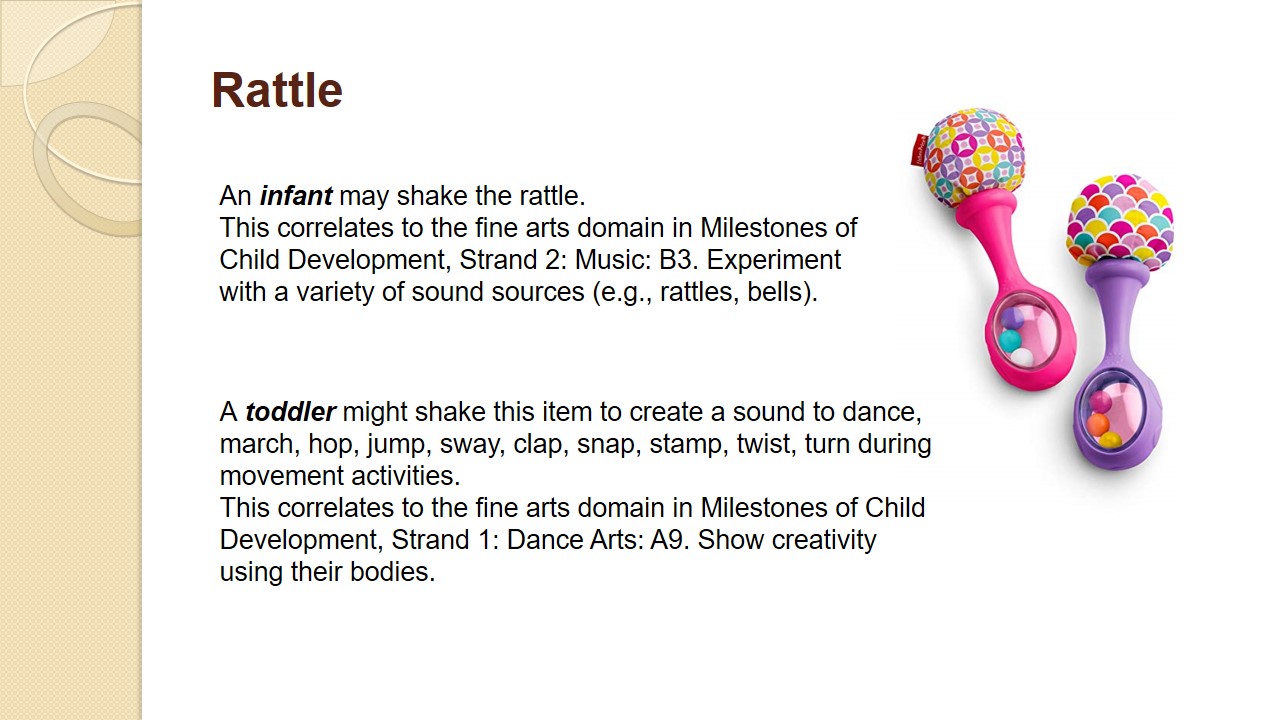
Wooden blocks of different shapes
An infant might attempt to place the square beanbag in the round hole.
This correlates to the cognition and general knowledge domain in Milestones of Child Development, Strand 1: Sub-Strand D. Shapes: D1. Explore geometric shapes in the environment.
A toddler might put together and takes apart shapes to make other shapes.
This correlates to the cognition and general knowledge domain in Milestones of Child Development, Strand 1: Sub-Strand D. Shapes: D7. Recognize three-dimensional shapes (e.g., cylinders, spheres, cones) through everyday experiences.
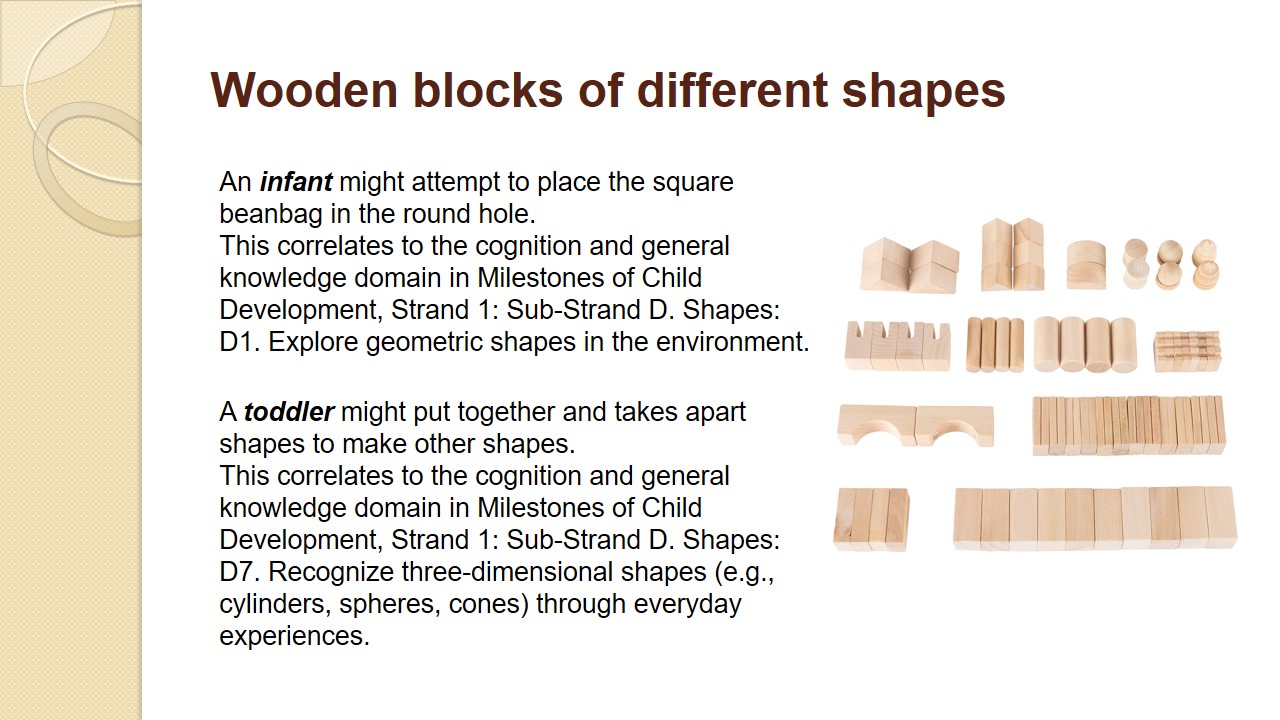
Mask with face shapes
An infant might use a variety of actions to explore the masks – touch, mouth, smell, shake, bang.
This correlates to the cognition and general knowledge domain in Milestones of Child Development, Strand 2: Sub-Strand A. Scientific Knowledge: A2. Recognize and respond to different sights, textures, smells, sounds, and tastes.
A toddler might put on a mask and use it as a prop to pretend to be an animal or one’s favorite character from the cartoon.
This correlates to the fine arts domain in Milestones of Child Development, Strand 3: Theater Arts: C9. Tell about and/or role-play characters from familiar stories or known people and own imagination.

Animal forms
An infant might babble in a flow of word sounds while pretending to “talk” to the stuffed animal.
This correlates to the fine arts domain in Milestones of Child Development, Strand 3: Theater Arts: C2. Imitate sounds, facial expressions, and gestures of another person.
A toddler might start asking “why” questions about the dinosaurs and history while playing with parents.
This correlates to the approaches to learning domain in Milestones of Child Development, Strand 4: Reasoning and Problem-Solving: D6. Demonstrate beginning understanding of cause and effect, especially of own actions.
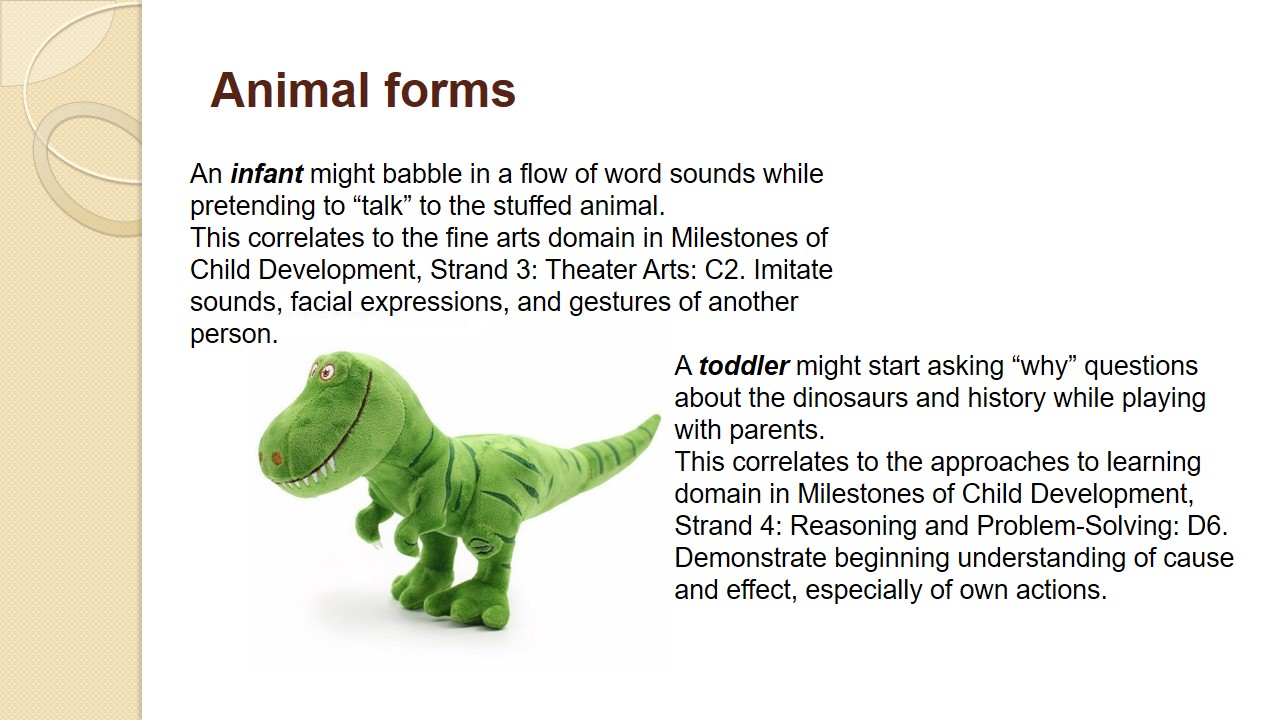
Set of four diversity dolls
An infant may examine a toy for a brief period of time.
This correlates to the approaches to learning domain in Milestones of Child Development, Strand 1: Persistence: A1. Observe objects and people for a brief period of time.
A toddler might pretend to do what he has observed others do (e.g., to dress up the toes, to organize a lunch for them, dance and sing with the dolls), but imitate specific behaviors rather than entire role.
This correlates to the fine arts domain in Milestones of Child Development, Strand 3: Theater Arts: C5. Imitate what others do.
A toddler might also try to feed the dolls as a play game that facilitates a practice of holding and using utensils such as spoons, forks, cups and bowls.
This correlates to the physical development and health domain in Milestones of Child Development, Strand 3: Health and Well-Being: C14. Demonstrate the stamina and energy to participate in daily activities.

Set of nesting cups
An infant might nest up to five cups, with assistance.
This correlates to the cognition and general knowledge domain in Milestones of Child Development, Strand 1: Sub-Strand B. Measurement: B2. Show some awareness of the relative size of objects.
A toddler may begin to fit pieces in correct openings and correctly stack a few nesting cups.
This correlates to the cognition and general knowledge domain in Milestones of Child Development, Strand 1: Sub-Strand C. Patterns and Relationships: C6. Understand the relationship between objects, matching similar shapes.
Nesting cups might be a good source for an infant to learn different sounds and noises when cups are hit together.
This correlates to the fine arts domain in Milestones of Child Development, Strand 2: Music: B3. Experiment with a variety of sound sources.
A toddler can use it as a measuring cup for scooping and pouring. Water, rice, or any other objects might assist here that can fill and empty the cups easily. This facilitates math, science and fine motor skills.
This correlates to the cognition and general knowledge, and physical development and health domains in Milestones of Child Development, Strand Strand 1: Learning About Mathematical Concepts. Sub-Strand B: Measurement: B10. Use standard tools to explore and understand the environment;
Strand 2: Fine Motor Development: B10. Persist in accomplishing more difficult fine motor tasks.
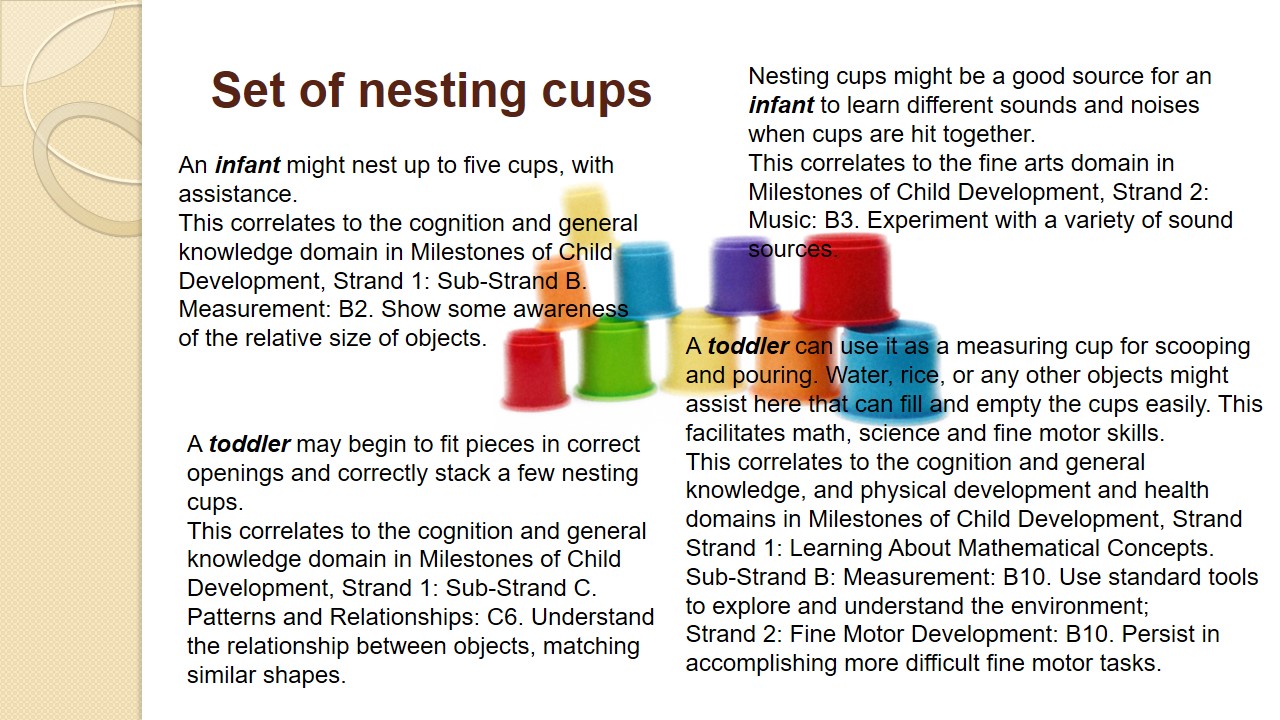
Soft cloth
An infant might use this item to explore the sense of touch and get excited with its soft material.
This correlates to the cognition and general knowledge domain in Milestones of Child Development, Strand 1: Sub-Strand F. Data Collection and Analysis: F2. Gather information through the senses (e.g. mouthing, grasping, reaching).
A soft cloth or any kind of cloth, such as scarf, towel, etc. can be a great way for an infant to practice strengthening its grasp and coordination.
This correlates to the cognition and general knowledge domain in Milestones of Child Development, Strand Strand 1: Learning About Mathematical Concepts. Sub-Strand F: Data Collection and Analysis: F2. Gather information through the senses (e.g., mouthing, grasping, reaching).
A toddler may use this item to learn to describe the variety of textures.
This correlates to the cognition and general knowledge domain in Milestones of Child Development, Strand 2: Sub-Strand A. Scientific Knowledge: A3. Observe and describe characteristics of things.
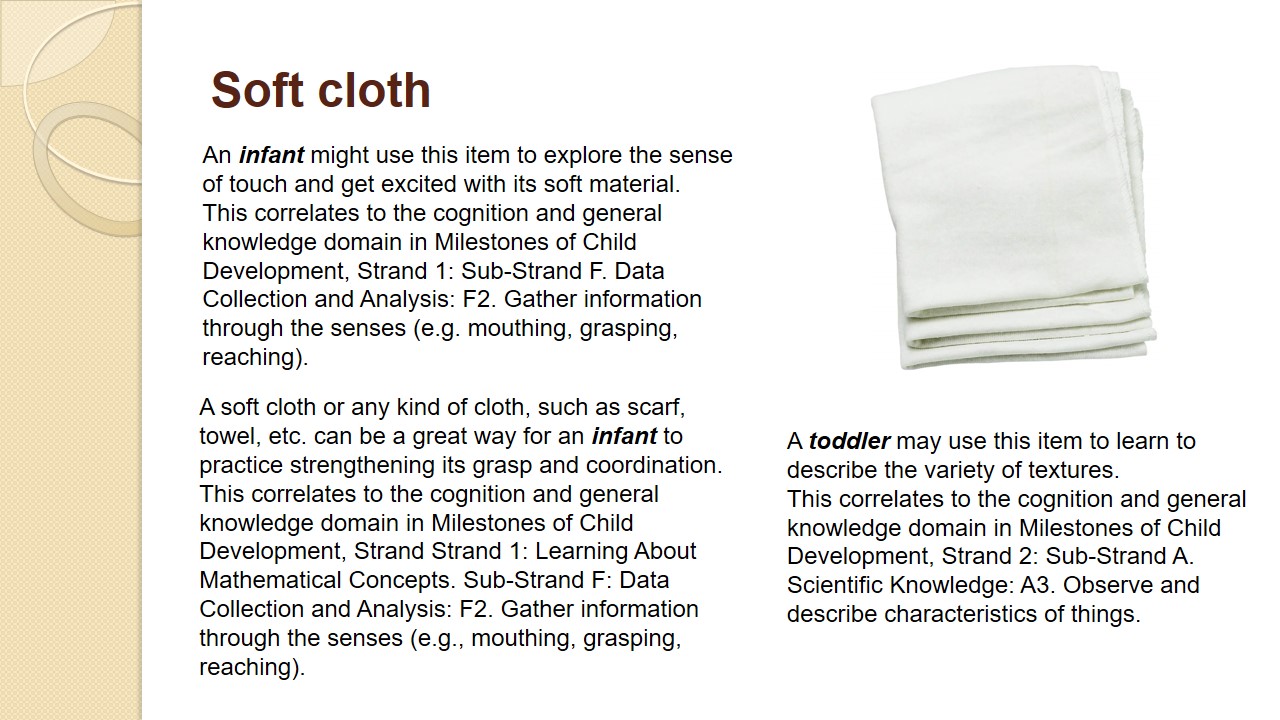
Dressing doll
An infant might explore the doll and her clothes to see what happens when it is pushed, pulled, punched, dropped, rolled, shaken.
This correlates to the approaches to learning domain in Milestones of Child Development, Strand 3: Creativity and Inventiveness: C1. Notice and show interest in and excitement with familiar objects, people, and events.
A toddler may use this item to talk about what she wants to be when she grows up by trying different styles and characters on the doll.
This correlates to the cognition and general knowledge domain in Milestones of Child Development, Strand 3: Sub-Strand C. Economics: C4. Develop awareness of jobs and what is required to perform them.
By interacting with other children, a toddler can practice language and social skills, including sharing, cooperation, helping, and problem solving.
This correlates to the social and emotional development domain in Milestones of Child Development, Strand 1: Relationships with Others: A13.Interact easily with one or more children and adults.
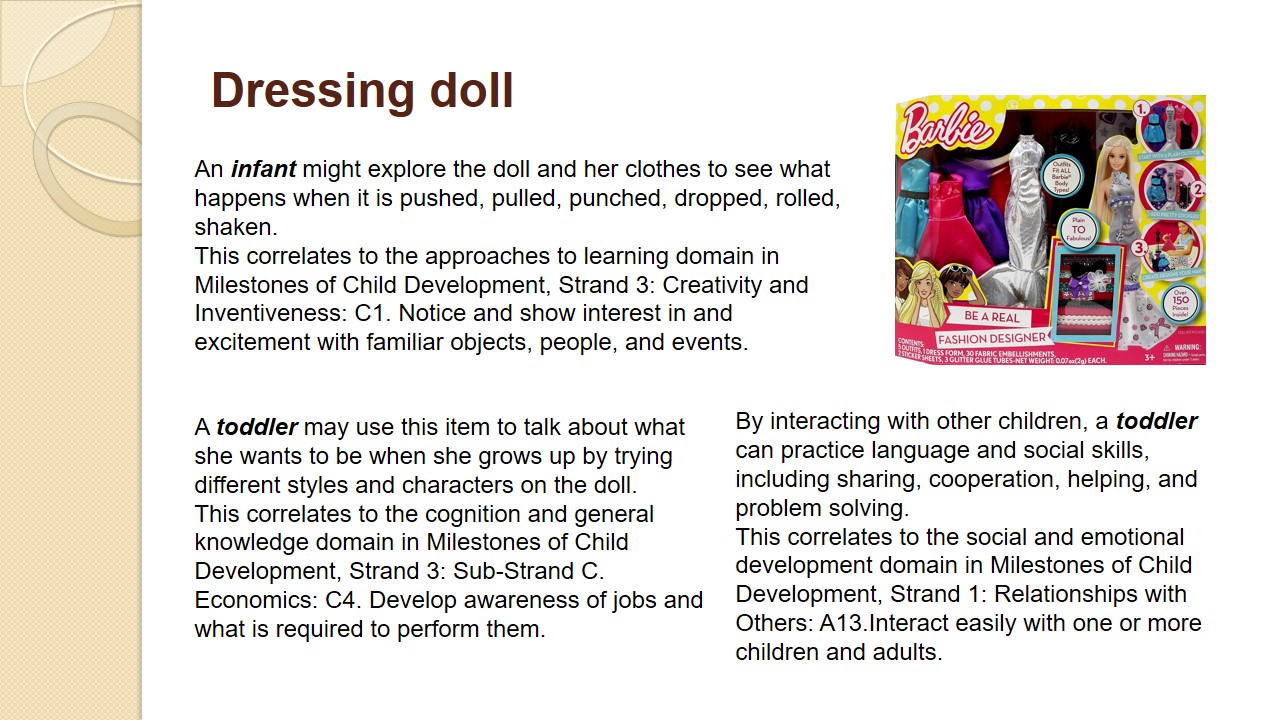
Soft book
An infant might focus on the person speaking while reading the book to it.
This correlates to the language and literacy domain in Milestones of Child Development, Strand 1: Listening and Speaking: B1. Show enjoyment of the sounds and rhythms of language.
A toddler might enjoy children’s books with themes of exaggeration, and develop vocabulary and speech whilst listening attentively to an adult reading it.
This correlates to the language and literacy domain in Milestones of Child Development, Strand 1: Listening and Speaking: A12. Enjoy hearing and creating humorous stories characterized by exaggeration;
Strand 4: Comprehension: D5. Show increased comprehension and response to stories read aloud.
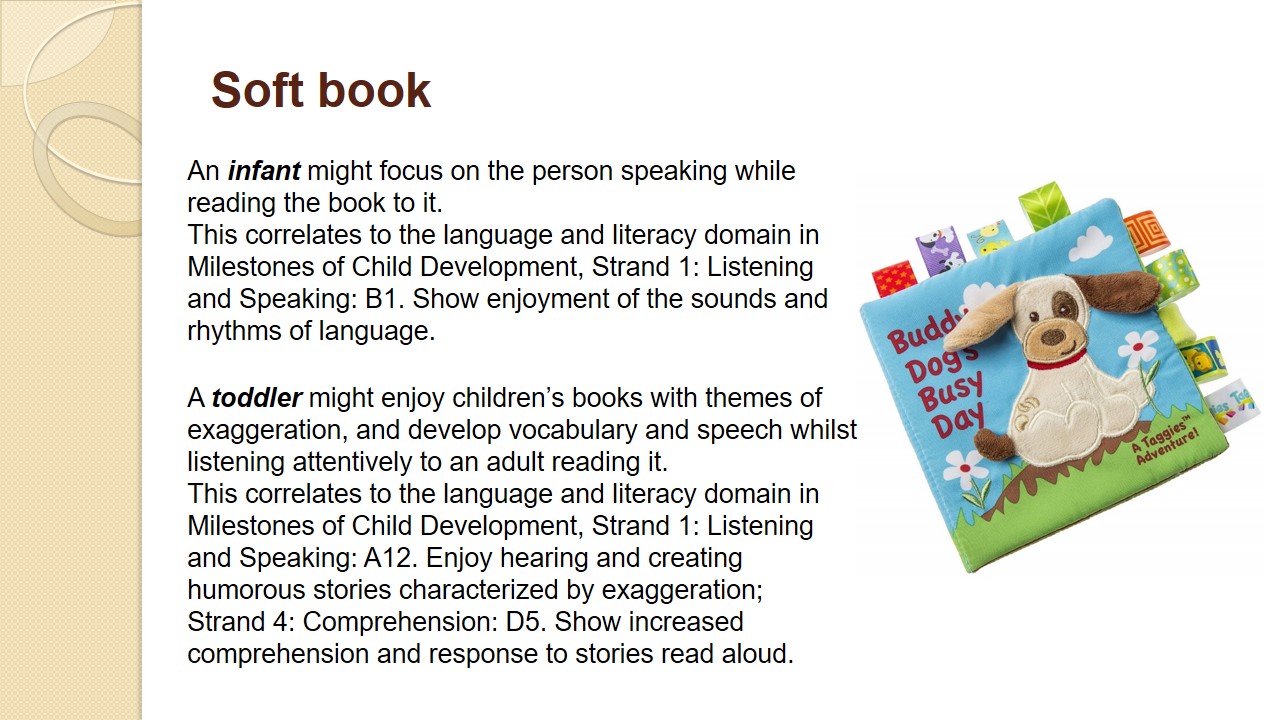
References
Milestones Of Child Development. Virginia Dept. Of Social Services, Office Of Early Childhood Development, 2008.
Petty, Karen. Developmental Milestones Of Young Children. Redleaf Press, 2009.